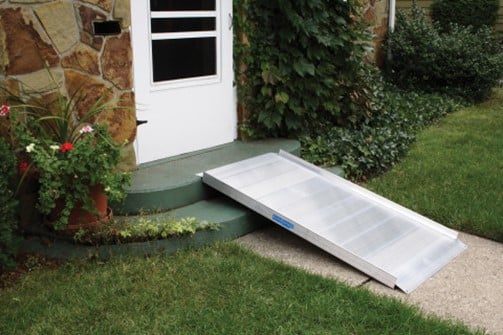Wheelchairs are one of the best inventions that have enabled people with mobility issues to participate in social activities and live life to the fullest. While it enables you to do most of the stuff yourself what if some places aren’t accessible just through a wheelchair to solve that equation we need a new element.
Wheelchair Ramps, When we roll into the world of wheelchair ramps. Cura360 will unravel the diverse types of ramps available and shed light on the key consideration factor for people seeking optimal accessibility solutions.
Cura360 will explore the various types of wheelchair ramps and delve into the essential factors to consider when choosing the right one. Join us on this journey to enhance accessibility and empower individuals with the knowledge they need to make informed decisions about wheelchair ramps. From modular systems to threshold ramps, we’re here to unravel the possibilities and guide you through the considerations that can make a substantial difference in creating barrier-free environments.
Types of Wheelchair Ramps
Wheelchair ramps come in various types, each designed to address specific mobility needs and overcome different architectural barriers. Understanding the characteristics and advantages of each type is crucial when selecting the most suitable ramp for a particular setting.
- Threshold Ramps: These ramps are designed to bridge small elevation changes, such as door thresholds or raised landings. Compact and portable, threshold ramps are often made of lightweight materials like aluminum or rubber, providing a quick solution for minimal height differences.
- Portable Ramps: Portable ramps are versatile solutions that can be moved and adjusted as needed. Typically made of aluminum, these ramps are lightweight and easy to transport, making them ideal for temporary access, such as for travel or events.
- Modular Ramps: Modular ramps consist of pre-fabricated sections that can be assembled to create longer ramps with varying configurations. These ramps are often made from aluminum or steel and offer a semi-permanent or permanent solution for overcoming larger elevation changes.
- Folding Ramps: Folding ramps are designed for easy transportation and storage. They feature a hinged design that allows them to be folded into a more compact size. These ramps are commonly made of aluminum and are suitable for overcoming moderate height differences.
- Aluminum Ramps: Lightweight and durable, aluminum ramps are a popular choice for both portable and modular ramp systems. They are resistant to corrosion, making them suitable for outdoor use, and they provide a sturdy surface for wheelchair users.
- Concrete Ramps: Permanent concrete ramps provide a durable and long-lasting solution for overcoming elevation changes. They are commonly used for public buildings and spaces where a permanent, fixed ramp is required.
- Rubber Ramps: Rubber ramps are known for their non-slip surface and shock-absorbing properties. These ramps are often used for both indoor and outdoor settings, providing a secure and comfortable transition for wheelchair users.
- Telescoping Ramps: Telescoping ramps are adjustable in length, allowing users to extend or retract them based on the specific height they need to overcome. This flexibility makes them suitable for a variety of settings and applications.
Factors to Consider Before Buying Wheelchair Ramps
Choosing the right wheelchair ramp decision will be influenced by many factors and you have to consider them all so you can make a smart decision that will make your life much easier.
- Ramp Type: Understand the different types of ramps available, including threshold ramps, portable ramps, modular ramps, and permanent ramps. The specific type needed will depend on factors such as the location, frequency of use, and the height of the elevation to be overcome.
- Ramp Material: Consider the material of the ramp, such as aluminum, wood, rubber, or concrete. Each material has its advantages and considerations, including durability, weight, and maintenance requirements. Ensure that the chosen material aligns with the intended use and environmental conditions.
- Weight Capacity: Verify the weight capacity of the ramp to ensure it can safely support the weight of the wheelchair and user. Consider potential changes in equipment or user weight over time to future-proof the investment.
- Portability and Storage: Assess whether portability and storage are essential considerations. Portable ramps are designed for easy transportation and storage, making them suitable for travel or temporary use. Consider the user’s lifestyle and mobility needs in determining the ramp’s portability.
- Surface Traction: Ensure that the ramp provides sufficient surface traction to prevent slipping, especially in wet or slippery conditions. Ramps with non slip surfaces or added traction features enhance safety during use.
- Budget: Establish a budget for the wheelchair ramp, considering both the initial cost and potential long term maintenance expenses. While budget considerations are important, it’s crucial to prioritize the safety and usability of the ramp.
- Consultation with Healthcare Professionals: Seek advice from healthcare professionals or occupational therapists who specialize in mobility and accessibility. Their expertise can guide the selection process based on the user’s specific needs and physical abilities.
Conclusion:
As we’ve explored the various types of ramps, from threshold ramps to modular and portable options, it becomes evident that there is no one size fits all solution. Each type caters to specific needs, making it crucial to align the choice of a ramp with the unique requirements of the user and the environment.
The importance of thoughtful decision making whether it’s the material, weight capacity, length, or compliance with regulations, each factor plays a vital role in ensuring the ramp not only meets immediate needs but also adapts to potential changes over time. So carefully consider all these factors before making any big decision as this decision will have a direct effect on your daily life.
If you’re still confused about choosing the right wheelchair ramps for your needs you can send us a message in our chatbox and ask for one of Cura360’s specialists to help and guide you in the selection for your needs.
You can also visit Cura360 for useful product information and photos. At Cura360, we are waiting to help you make the perfect decision. If you’re looking for something more than just a mobility aid, Cura360 can help you with its vast range of product lines specifically dedicated to making your life better.

 1-833-207-3433
1-833-207-3433

